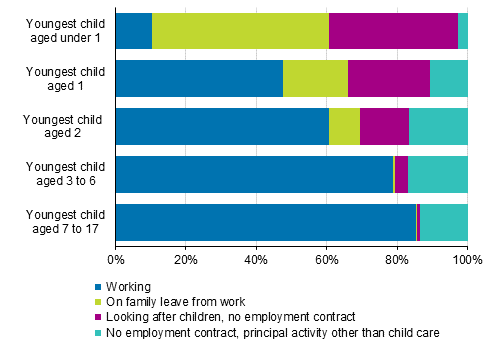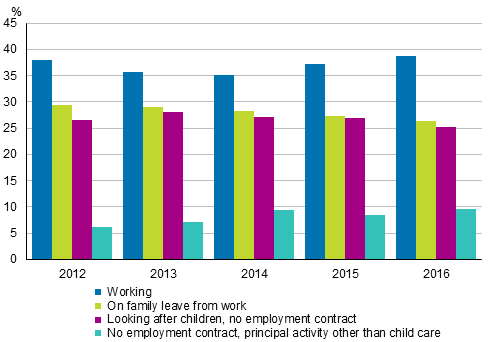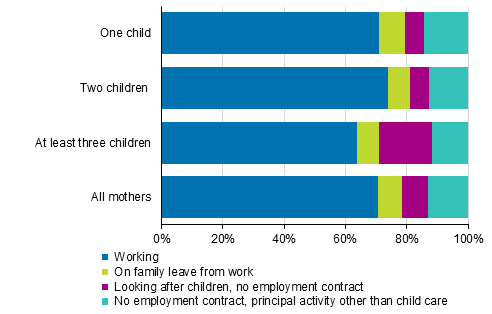4. More mothers with small children than before are working
However, the employment rate does not describe how many parents of young children actually work. In the Labour Force Survey employed are those who have worked for at least one hour during the survey week. In addition, employed are also those employees absent from work on the survey week who have a job and who are on maternity or paternity leave or whose absence for other reason has lasted under three months. Thus, especially in the case of mothers of small children the employed include plenty of mothers who are actually at home looking after a child. Respectively, mothers on child care leave are mostly classified as persons outside the labour force because the care leave is often taken after the maternity leave and parental leave, which means that the total duration of the leave is over three months. This section discusses parents who have been at work during the survey week.
Figures 6 and 7 show those mothers of children aged under three who were actually working as a separate group. They also describe separately mothers on family leave (maternity, parental or child care leave) from work and those without a valid employment contract who are looking after their children at home. The fourth group consists of those who have said their principal activity is something else than child care. This group includes such as students and unemployed persons.
Very few mothers with children under the age of one were working in 2016 but as many as nearly one-half of mothers with children aged one (Figure 6). When the youngest child was three to six years old, a majority of mothers had returned to work. Among all mothers of school-age children 85 per cent were working.
Figure 6. Working and family leaves among mothers aged 20 to 59 by age of their youngest child in 2016, %

In 2016, fathers had family leaves most commonly at the stage when the family's youngest child was one to two years old. Then five per cent of fathers were looking after a child/children either on family leave from work or without an employment relationship.
Mothers' education has a connection to working. Mothers with tertiary level education often have a valid employment contract throughout their family leave and they return to work faster than other mothers. This is already visible among mothers of children aged under three, but the differences get emphasised once the children have turned three. When the youngest child is aged three to six, as many as 88 per cent of mothers with tertiary level education are working, while this is so for 76 per cent among mothers with upper secondary level education. Thirty-six per cent of mothers without post-basic level education were working at this stage.
Figure 7 shows changes having taken place in recent years in working and family leaves among mothers of children aged under three. Over the past three years, the share of working mothers has grown slightly and the share of mothers on family leave from work and at home without an employment relationship has decreased. In 2016, good one-third of mothers with children aged under three were at home without an employment relationship. This group includes both mothers that primarily care for children at home and those whose main activity is something else besides caring for a child, such as studying or unemployment.Figure 7. Working and family leaves of mothers aged 20 to 59 with children aged under three in 2012 to 2016, %

Mothers who have no valid employment relationship and who said their principal activity was child care can be considered stay-at-home mothers. Interpreted like this, six per cent of mothers with one or two children can be classified as stay-at-home mothers. Seventeen per cent of mothers with at least three children were stay-at-home mothers in 2016, while three years earlier, the corresponding share was 23 per cent. Among all families with children, around one-fifth had at least three children.
Figure 8. Working and family leaves among mothers aged 20 to 59 by number of children in 2016, %

Source: Labour Force Survey 2016. Statistics Finland
Inquiries: Tarja Nieminen 029 551 3561, Anna P�rn�nen 029 551 3795, tyovoimatutkimus@stat.fi
Director in charge: Jari Tarkoma
Updated 10.10.2017
Official Statistics of Finland (OSF):
Labour force survey [e-publication].
ISSN=1798-7857. Families and work 2016,
4. More mothers with small children than before are working
. Helsinki: Statistics Finland [referred: 8.12.2025].
Access method: http://stat.fi/til/tyti/2016/14/tyti_2016_14_2017-10-10_kat_004_en.html

